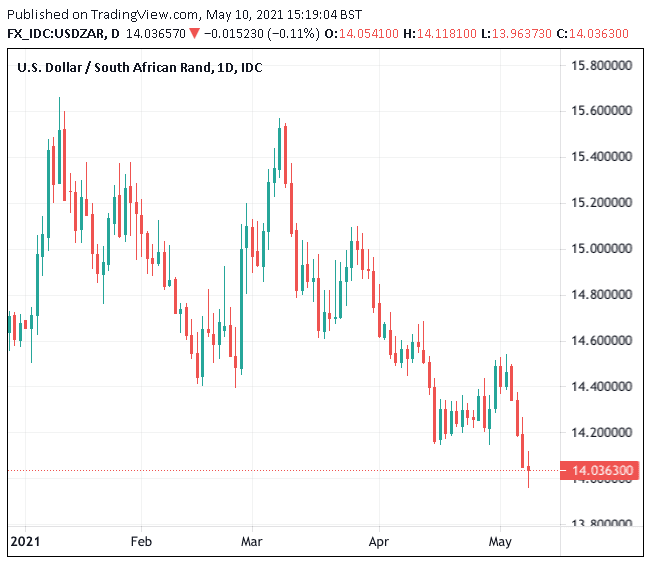South African Rand: Moody's Pass Opens Door to Gains, Goldman Sachs Urges Caution at these Levels
- Written by: Gary Howes
-

Image © Pound Sterling Live.
- GBP/ZAR spot rate at publication: 19.84
- Bank transfer rates (indicative guide): 19.10-19.30
- Transfer specialist rates (indicative): 19.67-19.70
- Get a specialist rate quote, here
- Set up an exchange rate alert, here
The South African Rand was left to run higher against the U.S. Dollar and other currencies at the start of the new week after Moody's on Friday declined to update their view on South Africa's finances, although analysts at Goldman Sachs are warning investors to approach the currency with caution at current levels.
All eyes were on Moody's on Friday night as the ratings agency was expected to take another look at South Africa's sovereign bond ratings.
There were fears that any further downgrades could prompt some caution amongst investors towards South African assets, thereby potentially denting the Rand's stellar 2021 performance.
"Moody’s is giving SA a window to repair its government finances after the blowout years of corruption of the 2010s decade which decimated the fiscus, before the spending pressures (and revenue collapse) from the COVID-19 lockdown last year worsened the situation," says economist Annabel Bishop at Investec.
Above: The Rand's advance against the Dollar.
The review would have been a rare chance to focus on the Rand's domestic story, given the currency has been a star performer in the Emerging Market space in 2021 as investors hunt out the strong returns offered by South African equities and sovereign bonds.
The external environment remains supportive of the currency thanks to rising commodity prices which have provided support to South Africa's significant raw material and precious metal export sector, aiding the country's trade balance.
A fall in the U.S. Dollar on Friday in the wake of some disappointing jobs data meanwhile only provided an additional boost to Emerging Market assets and commodity-linked currencies such as the Rand ahead of the anticipated ratings review.
"In late February, we’d flagged that global tailwinds could eventually push the Rand stronger, despite some domestic headwinds. In recent sessions, those tailwinds have come through: a renewed rise in commodity prices (especially copper), together with continued softness in back-end US yields, has helped to drive USD/ZAR near post-coronacrisis lows," says analyst Zach Pandl with Goldman Sachs.
The Pound-to-Rand exchange rate is now down 1.10% already in 2021 amidst Rand outperformance, with Euro-to-Rand rate declining 5.0%.
The Dollar-to-Rand exchange rate is meanwhile down 4.50%.
However, concerns over the state of South Africa's finances will likely be a persistent negative in the South African Rand story book that could cap advances.
"Any indication that the SA government will cave in to severe pressures for higher wages from civil servants, parastatal employees and any other renumeration pressure on the fiscus would reduce SA’s ability to avoid further credit rating downgrades," says Bishop.
Secure a retail exchange rate that is between 3-5% stronger than offered by leading banks, learn more.
For now though the ratings story is considered to be a concern for the coming months by Investec.
"With Moody’s pausing to provide a grace period on SA, Fitch which also has SA on a negative outlook at BB- could do the same, and indeed we expect it will, and this has allowed us to slightly increase the probability weighting of the expected case and lower that of the lite down," says Bishop.
Pandl at Goldman Sachs meanwhile says that while there remains a case for investors to be 'long' on the Rand, "tactical caution" should be deployed at these levels.
A concern for the analyst is another potential rally in U.S. bond yields which tend to be supportive of the U.S. Dollar while providing headwinds for Emerging Market assets.
"In-line with our empirical work, which shows that the Rand is one of the EM currencies that is most-sensitive to a move in US yields (even on a vol-adjusted basis), the Rand has traded closely with back-end US yields in recent sessions. A back-up in core rates could be an important headwind," says Pandl.
U.S. rates had risen in the first quarter of 2021 as investors prepared for higher rates of inflation in the U.S.
This bid the Dollar and saw the Rand retreat.
Yields have however since settled, allowing the Rand and associated 'risk on' assets to climb. The concern at Goldman Sachs however is that a fresh advance in these yields could be due, which could in turn limit the Rand's potential.
A concern amongst investors is that inflation will surge in the U.S. over coming months as a generous government spending stimulus meets with global supply chain constraints.
Should inflation shock to the upside U.S. bond yields could start climbing once more as investors demand greater compensation (yield) for holding U.S. government bonds.











